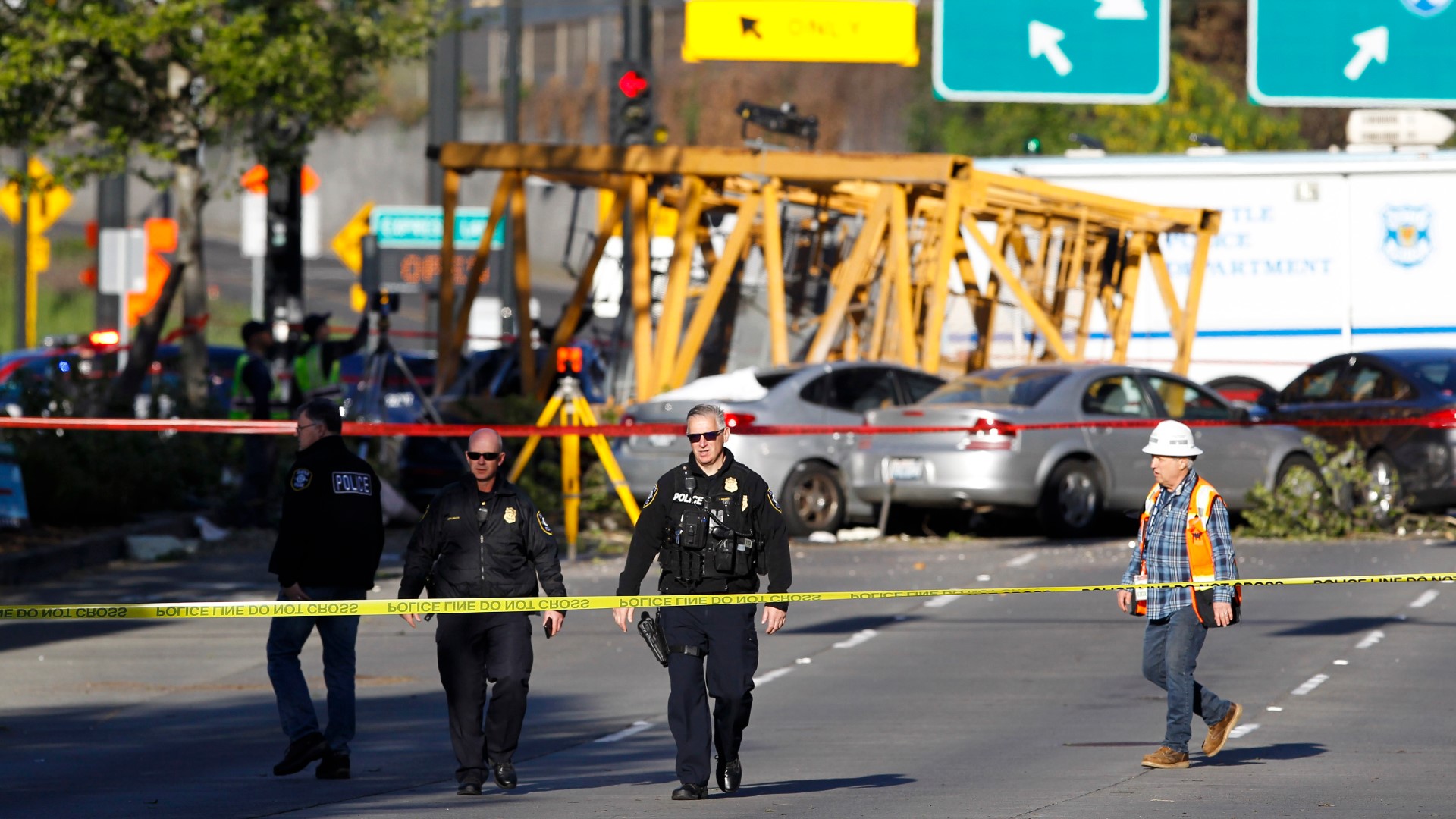SEATTLE — Three crane companies have been fined more than $100,000 by the Department of Labor & Industries (L&I) for several violations that led to the deadly crane collapse in Seattle.
Four people died on April 27 when a crane tower collapsed in South Lake Union.
L&I’s nearly six-month investigation determined that the crane collapse was caused by the companies not following the manufacturer’s procedures for dismantling the structure, which included prematurely removing nearly all of the pins and sleeves that helped hold the crane together.
The early removal of those pins caused the crane to break off and fall when it was hit with a 45 mph gust of wind. Without the pins and the sleeves in place, the wind was too much for the structure to handle.
The Seattle Police Department confirmed Thursday they are investigating the crane collapse. Seattle police said they were waiting for L&l to complete their work before moving forward with a criminal investigation.
The results of their investigation will be forwarded to the King County Prosecutor's Office.
RESPONSIBLE PLAYERS:
Morrow Equipment Company, one of the five companies hired to oversee and assist with the disassembly process, received the most serious local violation.
L&I said that Morrow Equipment "acted with intentional disregard or indifference" for safety.
Morrow supplied the nearly 300-foot tower crane used at the site. However, L&I determined that the technician failed to follow disassembly recommendations set by the manufacturer.
Morrow Equipment was cited for $70,000.
State investigators also levied three serious violations against two other companies: GLY Construction and Northwest Tower Crane Services.
GLY was the general contractor for the site and Northwest Tower Crane Service provided the employees for the project.
The state alleges that the companies did not ensure the disassembly process was supervised by a qualified person and that site employees were not aware of the hazards of not following manufacturer recommendations.
In response to the citation, GLY issued the following statement:
“The safety of our job sites is always our number-one priority, and we take very seriously anything that impacts the well-being of our employees and the communities and clients we serve. We are deeply concerned by what happened in Seattle, and our hearts continue to go out to the victims and their families.
Since the tragic crane accident in Seattle on April 27, 2019, we have been cooperating fully with authorities managing the investigation. We have already made changes to our systems and implemented protections based on immediate key learnings from the event, and we remain committed to upholding strict industry safety protocols at all of our jobsites.
We are actively reviewing today’s report from the Department of Labor and Industries on the crane collapse and will use its findings to do everything possible to protect our workers and the community. This report follows GLY’s own internal investigation and rigorous safety assessment to determine further protocol changes and improvements.
The impact of this event will be felt for some time and we will use it to strengthen and safeguard our employees and the communities in which they work.”
GLY was fined $25,200 and Northwest Tower Crane is facing a $12,000 fine.
The three companies received their notes of citation on Thursday. They have 15 days to file an appeal.
HOW THE CRANE FELL:
Tower cranes are comprised of 20-foot steel sections, held together by connecting pins and sleeves. Crews are not supposed to remove pins from a section until the section is attached to the assist crane that is disassembling the tower crane.
When all are attached, the crane acts as one structure instead of separate parts.
Brian Haight, L&I’s crane-certification supervisor, said crews removed more than 50 pins from the entire length of the structure, leaving only one pin in place.
“Per the manufacturer’s procedures, it wasn't acceptable to remove any pins for any component other than the one that was attached to the mobile crane, ready to be removed. The likely supposition is that it helps them to get the work done faster," according to Haight.
DIRECT AFTERMATH:
The victims included 19-year-old Sarah Wong, a freshman at Seattle Pacific University. Also killed were two ironworkers, Travis Corbet, 33, and Andrew Yoder, 31, who were disassembling the crane. The fourth victim was identified as 71-year-old Alan Justad, a long-time employee for the City of Seattle.
A Pennsylvania-based attorney previously said the collapse in Seattle was similar to a crane collapse in Dallas in 2012. David Kwass said video seems to show the ironworkers struggling to connect the crane with another assist crane. Kwass said if the disassembly of the bolts was done prematurely, only the slightest adjustment of weight at the top could result in the crane to tumble.
Seattle Department of Transportation (SDOT) records show that Omega Morgan, one of five companies investigated for the collapse, only asked for Valley Street to be closed during the removal.
Records also revealed the company asked to perform the two-day disassembly the prior weekend, but SDOT rejected the request citing an event conflict.
Omega Rigging and Machinery and Seaburg Construction were not cited for any violations.
The company’s request fell in line with similar removal plans and current city guidelines.
“The incident that occurred was totally avoidable,” said Joel Sacks, L&I Director. “If the companies on site had followed the rules that were in place, the crane would not have fallen and four people would not have lost their lives.”
Read more on the crane collapse:


